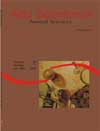<b>Profile of <em>n</em>-alkanes in five species of plants tropical forages</b> - DOI: 10.4025/actascianimsci.v27i3.1207
Abstract
This experiment aimed to study the profile of n-alkanes in tropical grasses species (Brachiaria brizantha, Cynodon dactylon and Panicum maximum) and legumes (Arachis pintoi and Glycine wightii). They were identified and quantified, through gas cromatography, the n-alkanes C24 to C35, being the alkanes C32 and C34 internal indices. The n-alkanes concentrations in the different species and respective fractions (leaf blade, stem higher and lower portion and dead matter for grasses; leaves, stem higher portion, stem lower portion and dead matter for legumes) were submitted to variance analysis and mean test (Tukey). For most of the species and fractions, there is prevalence of odd chain n-alkanes during springtime and winter. There was larger concentration of the alkanes C29, C31 and C33 in springtime, C27, C28, C29, C30 and C31 in summer and C27, C29, C31 and C33 in winterDownloads
Download data is not yet available.
Published
2008-03-19
How to Cite
Côrtes, C., Damasceno, J. C., Massaru Fukumoto, N., Shiguero Sakaguti, E., Ferriani Branco, A., & Cecato, U. (2008). <b>Profile of <em>n</em>-alkanes in five species of plants tropical forages</b> - DOI: 10.4025/actascianimsci.v27i3.1207. Acta Scientiarum. Animal Sciences, 27(3), 309-317. https://doi.org/10.4025/actascianimsci.v27i3.1207
Issue
Section
Pasture and forage utilization
DECLARATION OF ORIGINALITY AND COPYRIGHTS
- I Declare that current article is original and has not been submitted for publication, in part or in whole, to any other national or international journal.
The copyrights belong exclusively to the authors. Published content is licensed under Creative Commons Attribution 4.0 (CC BY 4.0) guidelines, which allows sharing (copy and distribution of the material in any medium or format) and adaptation (remix, transform, and build upon the material) for any purpose, even commercially, under the terms of attribution.
Read this link for further information on how to use CC BY 4.0 properly.
0.9
2019CiteScore
29th percentile
Powered by 








































